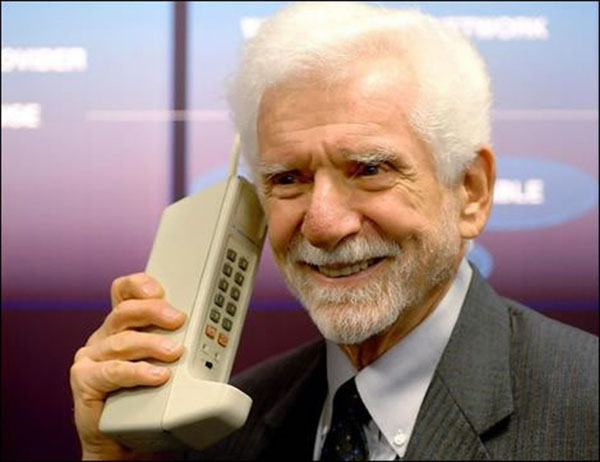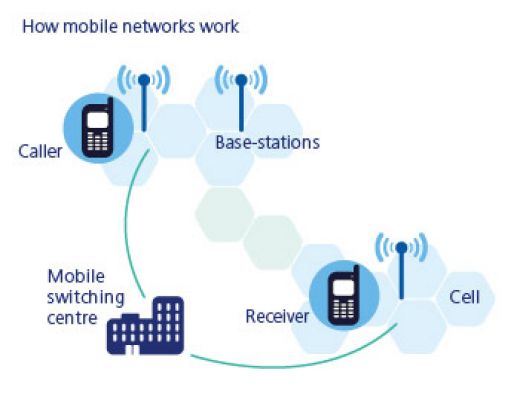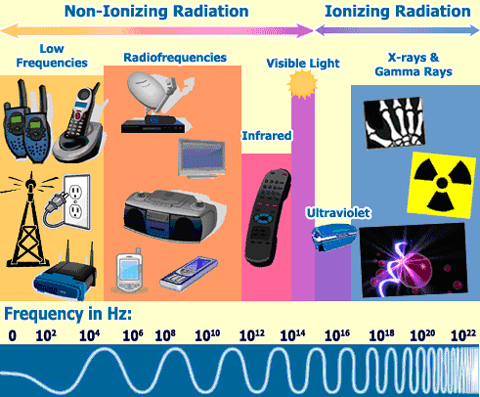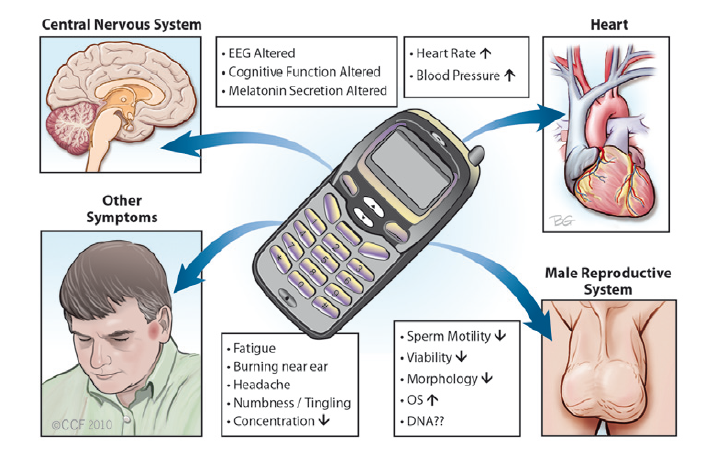Many factors contribute to the potential health risks of cell phones. Learn what they are, and how you can protect yourself.
I don’t know about you, but in the early 1990s I wanted one of these:

P.S. Shut up.
To me, radio transmissions from cell phones are kinda irrelevant. I forget about them and instead focus on important stuff, like what I’m going to eat for lunch. But just because I can’t see or touch radio transmissions, they still exist.
There are advantages to cell phones: making emergency calls, catching up with friends, getting business done while on the bus, and so forth.
But what about any disadvantages?
Cell phones: a growing phenomenon
In 1996, there were 15 million U.S. cell phone subscribers. In 2000, there were 110 million U.S. cell phone subscribers. Now (2012), there are over 303 million U.S. cell phone subscribers (the total U.S. population is 311 million).
Half of all eight year olds have a cell phone. 75% of twelve year olds do too.

How do cell phones work?
Cell phones are a complex, low powered radiofrequency transmitter. Radiofrequency energy is a form of electromagnetic radiation. Electromagnetic radiation is used to transmit information from cell phones to base stations/antennas.

How safe is electromagnetic radiation?
Electromagnetic radiation can be ionizing (e.g., X-rays) or non-ionizing (e.g., cell phones & microwave ovens). Our bodies absorb radiation.

While our cell membranes appear to block non-ionizing radiation, we’re not sure how it influences our overall health long term.
For instance, some folks who live by base stations report various health conditions. Still, no data indicate a direct cause/effect relationship here.
The SAR (specific absorption rate) is a measure of radiofrequency energy absorption by the body. The FCC requires that handheld mobile devices not exceed 1.6 watts/kg (e.g., the iPhone 3G = 1.39). Behaviour in animals appears to be disrupted at 4.0 watts/kg.
The problem of safety standards
Radiofrequency safety standards were based on the following imaginary person who:
- was 6’2″;
- was over 200 pounds;
- had an 11 pound head; and
- talked on a cell phone for 6 minutes at a time, without placing it directly against the skull (before you laugh at the idea of holding a cell phone one inch away from your brain, it’s been estimated that for every millimeter of distance that a cell phone is held away from the head, exposure is lowered by 10%).
Well, based on demographic data, not many folks are that “average person” — the average U.S. male is about 5’10” and the average female is 5’4″. And those are the adults. Remember, 75% of twelve year olds have a cell phone. As you might imagine, they don’t quite measure up to the radiofrequency safety standards model.
Plus cell phones are changing.
The old school Zack Morris cell phone operated at 902.5 MHz. Modern cell phones are double this. Zack Morris cell phones had antennas that extended out from the phone. Modern antennas are built into the phone. This means transmissions are closer to the brain.
So what does this mean for our health?
The potential health risks of cell phones
Just because cell phones are available to purchase doesn’t mean they’re a good idea to use.
The United States FDA does not test cell phone safety. Most of the information provided to us as consumers comes from industry. And neither party — government nor private industry — necessarily has our best interests in mind.
The International Agency for Research on Cancer (World Health Organization) has deemed electromagnetic fields from cell phones as possibly carcinogenic (same as lead, chloroform and engine exhaust).
Yet “possibly carcinogenic” doesn’t mean “definitely harmful”. One problem with figuring out the true risks is that there are many variables to consider with cell phone use, such as:
- who’s using the cell phone;
- how long they’ve used it;
- how frequently they use it, and/or how long their calls last;
- what kind of phone it is;
- where they use it; and
- surrounding cell phone traffic.
For every study that outlines something negative related to cell phones, there is another study showing no effect. As you can imagine, it’s tricky to find solid conclusions. And many studies related to cell phones were funded by organizations that have a vested interest in promoting cell phone use.
However, even if we don’t yet have solid data, we can make some informed guesses based on what we do know about radiation and the way the body works.
How cell phones might harm the body
Scientists speculate that cell phones might harm our bodies in a couple of ways:
- Thermal: Radiation can elevate body temperature (think: microwave oven). With a cell phone in our pocket or by our head, slight temperature increases might disrupt cellular functioning. The eyes and testes appear especially susceptible.
- Non-thermal: Radiofrequency energy can alter cell membrane permeability, the movement of calcium ions, cell excitability, free radical production, blood-brain barrier integrity, the stress response and/or neurotransmitter release.
The role of the blood-brain barrier (as in the non-thermal effect) may be key.
When the blood-brain barrier loses integrity, it gets leaky, and microorganisms moving around the body have a better chance of entering the brain space. Rats exposed to 900 MHz radiofrequency (the strength of the old Zack Morris phone) show a leaky brain.
Leakage across the blood-brain barrier also appears in the pathophysiology of multiple sclerosis (MS). Still, observational studies have found little association in humans between cell phone use and the development of MS (though data have indicated that MS symptoms might get worse with cell phone use).
Another thought is that increased cell phone usage can lead to increased oxidative stress (with concurrent decreases in antioxidant function). More oxidative stress is associated with a host of problems, such as damage to DNA, enzymes, lipids and proteins.
Whatever the mechanism, it seems clear that cell phones may have wide-ranging health effects on several body organs and systems.
Effects on brain health
Data indicate that the brain is susceptible to electromagnetic field radiation.
When we hold a cell phone by our head, the electromagnetic fields can penetrate up to 6 cm inside the brain. Nerves innervating the eyes and ears may also be exposed to cell phone radiation. Some cell phone users have reported blurred vision, difficulty concentrating and tinnitus (ringing in the ears).
There are some associations between cell phone (and cordless phone) use and brain cancer, with the highest risk in those under the age of 20 years. Tumors in the brain/neck seem to be higher in those who have used cell phones for more than 10 years.

There are a few indicators of how cell phone use might affect the brain. For example:
- Brain glucose metabolism around the area of the cell phone antenna tends to increase while the cell phone is in use (by the head).
- Alpha brain waves (a sign of relaxed brain activity) seem to increase with cell phone use. Data isn’t consistent here and variations might be due to the type of cell phone used.
- Cognitive performance (e.g. attention and memory) are another possible indicator, but data on the cognitive effects of electromagnetic fields from cell phones are mixed. Overall, the trend shows no major impact (note: many of the tests used in the studies were very simple). One study in mice found that low amounts of radiation from cell phones might actually help to fight off Alzheimer’s disease (the study has been criticized by experts).
Effects on reproduction, fertility & pregnancy
There are some potential problems with electromagnetic radiation and testicular tissues. For example:
- More cell phone use is correlated to less sperm motility, altered sperm morphology (in other words, funny-looking wigglers) and a decreased sperm count. Animal studies have shown decreases in testicular size and sperm cell death with exposure to electromagnetic radiation.
- Cell phone radiation might also lead to lower testosterone and testicular cancer.

If pregnant women use cell phones, there seems to be a greater chance that their children will have behaviour problems or hyperactivity.
Effects on sleep & immunity
While the exact relationship isn’t clear, it seems that cell phone use might affect sleep patterns and neuroendocrine function. For example:
- We know that the light from electronic screens can affect our brain’s circadian clock. Electromagnetic radiation can also alter melatonin production and brain activity during sleep. Melatonin is involved with sleep, metabolic health, and other processes.
- Some cell phone users report more fatigue and headaches might also increase. It’s unclear if these factors are related to other variables (like overworking, or constantly focusing the eyes to see the text on the screen).
- There are associations between cell phone use and the development of non-Hodgkin’s lymphoma.
Effects on kids & youth
“I believe that 30% of all childhood cancers are associated with electromagnetic field exposure.” — Dr. David Carpenter, Dean at the School of Public Health State University of New York
Ah, the kids these days, with their funny pants, their rock music, and their cell phones. And maybe, their poor health thanks — in part — to cell phones.
Young brains continue to develop well into the third decade of life, and of course our brains are at their busiest when we are young. Plus, in case you haven’t noticed, children are smaller people than grownups.
So, the brains of children and teenagers may be more susceptible to electromagnetic radiation. Indeed, many concerned parents and phone-happy kids have reported symptoms related to cell phone use, such as sleep problems, dizziness, fatigue, asthma, behavioral problems, etc. However, without solid experimental data, much of this remains anecdotal.
Data show that young folks who use cell phones have diminished memory. Is this because the phones store things like phone numbers and addresses (which means we don’t have to work to remember them), or because we’re distracted by texting, or some other reason? Hard to say.
Effects on skin & joints
Modern technology has been implicated as a cause of various skin conditions, often to the hands and face. Cell phone dermatitis can be related to nickel, chromium, and/or cobalt sensitivity.
Frequent users of smart phones have also reported conditions such as “Blackberry thumb” and “phone neck” — minor but still annoying tendonitis or muscle pain.
Effects on driver attention
We think we’re better multi-taskers than we really are, and cell phone use while driving is no exception.
Some research suggests that talking on a cell phone while driving is effectively like driving while impaired. In fact, a study at the University of Utah that compared drunk drivers to drivers on cell phones even found that “cell phone drivers exhibited greater impairment than intoxicated drivers”. Ouch.
The U.S. National Highway Traffic Safety Administration (NHTSA) estimates that of all the traffic accidents caused by distracted drivers, about 20% of those involved cell phone use.
As a result, many regions have banned cell phones for drivers outright, or restricted cell phone use to hands-free devices only.
Environmental effects
Cell phones aren’t just a health hazard while we’re using them. They can be a health hazard before and after we use them, too.
Producing new cell phones requires precious metals to be extracted from the earth. This is resource-intensive and generates tons of carbon dioxide. This can impact global weather patterns.
An expensive mineral called coltan is a component of cell phones. It can resist heat and store an electrical charge. It’s found mainly in regions of the Democratic Republic of Congo, and the mining and production process often involves child/youth labour and environmental hazards. Riverbeds must be cleared, toxic waste is generated, and mining zones include areas that are home to gorillas (gorilla populations in Congo have decreased by 90% in the last several years).
Despite the difficulty of producing cell phone materials, we don’t treat our phones as permanent investments.
Worldwide, more than 1.2 billion cell phones were sold in 2009. And the average consumer only keeps their cell phone for 18 months. More than half of cell phones are replaced because we get tired of the design.
What happens when they are discarded? Cell phones are classified as hazardous waste. Their components include non-degradable plastics and often, heavy metals.
Unfortunately, the U.S. recycling rate on cell phones is only 8%. Yikes.
Thus, cell phones can also affect our health even when we aren’t using them.

Summary and recommendations
“I think that in 20 years we’ll look back on cell phones in the same way we look back on cars and alcohol. They have valuable functions in society, but when misused they can kill you.” – Devra Davis, PhD, MPH
It’s still not clear exactly how risky cell phones are for both us and our environment. We still don’t know all the factors involved, nor which ones are most harmful to us.
But when put together, all the data on cell phones suggest that we should be careful. If we wait for scientific “proof” on this issue, it might be too late.
Luckily, we can implement simple, low-cost preventive measures right now to help keep ourselves safe.
- Simplify your phone. Additional capabilities on cell phones might mean additional health risks.
- Use it less. If you can use a landline for a call (i.e., phone with a cord), do it.
- Turn it off. A cell phone only emits radiation when it’s turned on.
- Text more. Texting can reduce radiation exposure to the brain.
- Set limits for kids. Use landlines for most calls.
- Find a phone with a lower SAR value (see resources below)
- Don’t hold a cell phone next to your head. Use a hands free device/ear piece. Use the speaker function when possible.
- Keep cell phones away from your body. Instead of keeping them in your pocket, keep them in a purse, man-purse or backpack. The further the cell phone is away from your body, the less exposure you have to the radiofrequency (another benefit of texting).
- Pregnant women: don’t keep a cell phone next to your body (when it’s turned on).
- Men: avoid keeping a cell phone in your pocket (when it’s turned on).
- Use the quiet car. If you can ride the car on the train that prohibits cell phones, you’ll be exposed to less electromagnetic radiation. If everyone around you has a switched-on cell phone, you are getting exposed to more electromagnetic radiation.
- Don’t sleep with your cell phone on your nightstand.
- If you can get your cell phone repaired and avoid buying a new one, do it. Cell phone waste is a major problem.
- When you must discard your cell phone, make sure to recycle it properly or donate it (see resources below).
Resources
- Highest radiation cell phones
- Lowest radiation cell phones
- SaferPhoneZone.com
- Is there a cell phone antenna near you?
- Environmental Working Group Guide to Safer Cell Phone Use
- A major study, known as COSMOS, was launched in 2010 in Europe, tracking cells phone users for 20 years. Another study is mobi-kids.
Cell phone recycling & donation resources
- Call2recycle.org – just enter your zip code and find a drop off location
- United States Environmental Protection Agency Recycle Cell Phones – options for drop off or mail-in recycling
References
Click here to view the information sources referenced in this article.
Learn more
Want to get in the best shape of your life, and stay that way for good? Check out the following 5-day body transformation courses.
The best part? They're totally free.
To check out the free courses, just click one of the links below.




Share